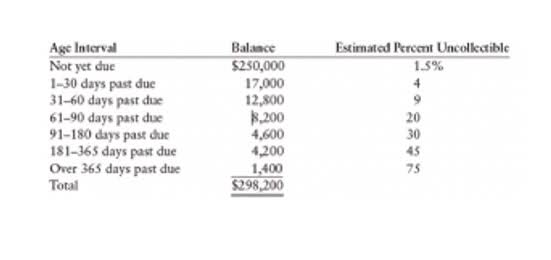Calculate Bad Debt Expense Methods Examples

If you’re interested in learning more about how HubiFi can help optimize your financial operations, schedule a demo today. An aging schedule is an essential tool in receivables management that helps businesses monitor outstanding invoices by categorizing them based on how long they’ve been overdue. This approach enables companies to maintain control over their cash flow, identify high-risk accounts, and prioritize collection efforts effectively. Here’s a guide on managing aged receivables, monitoring overdue accounts, and using targeted collection strategies based on the age of receivables. For example, if your AR aging report Statement of Comprehensive Income shows a significant number of invoices are more than 90 days overdue, it’s a red flag. This signals a potential cash flow problem and encourages you to take action.
Impact of Aging Method and Allowance for Doubtful Accounts on Financial Statements
Knowing which invoices are overdue and for how long allows you to anticipate potential shortfalls and adjust your financial plans accordingly. Late payments pose a significant risk to your cash flow, so regularly reviewing your aging report helps you identify and address potential issues before they snowball. This proactive approach empowers you to make data-driven decisions, ensuring you have the resources you need, when you need them. The aging of receivables method and the percentage of sales method are both used to estimate uncollectible accounts, but they differ in focus and approach.
What Is the Best Strategy for Managing Overdue Accounts in an AR Aging Report?
- We provide tips, how to guide, provide online training, and also provide Excel solutions to your business problems.
- At HubiFi, we understand the importance of clear financial data for strategic decision-making.
- This can save you time and reduce errors, freeing you up to focus on other aspects of your business.
- An aging report is a critical financial tool for tracking and managing accounts receivable.
- Let’s assume that a company’s Accounts Receivable has a debit balance of $89,400.
For businesses with high-volume transactions and complex data integrations, a solution like HubiFi can automate these processes and provide greater visibility into your financial data. You can also learn more about financial reporting and revenue recognition on the HubiFi blog. This method allows companies to calculate a total allowance for doubtful accounts, helping them prepare for potential revenue losses. Interpreting your accounts receivable aging report is key to healthy cash flow and smart business decisions.
- By promptly addressing these overdue invoices, businesses reduce payment delays and maintain a steady cash inflow.
- The content in this article is for general information and education purposes only and should not be construed as legal or tax advice.
- Understanding your customer payment patterns is essential for accurate interpretation.
- HubiFi’s automated solutions can seamlessly integrate with your existing systems to streamline this entire process.
- So, based on its historic estimates, the company should create a bad debt allowance of $16,440 to offset unpaid invoices.
Overcoming Resource Constraints in AR Management
This method is often referred to as a balance sheet approach, as it emphasizes the accounts receivable account, while the percentage of sales method is more aligned with the income statement. Make sure your invoices clearly state payment deadlines, accepted payment methods, and any applicable late fees. This transparency helps avoid misunderstandings and encourages timely payments. You can also adjust credit terms (payment deadlines, credit limits) based on individual customer payment history. If a customer consistently pays late, you might consider shortening their payment terms or requiring upfront payment.
InvoiceSherpa streamlines this process by automating invoice tracking, aging reports, and reminders, allowing businesses to efficiently monitor receivables and address overdue payments. Understanding industry benchmarks and statistics helps you assess the health of your own AR aging. For example, many businesses struggle with late payments; a surprising 68% of companies receive over half of their payments after the due date.
Thankfully, several tools and software solutions can simplify this process and provide valuable insights into your outstanding invoices. The AR Aging Report highlights overdue invoices and offers insights into the collection process. https://www.bookstime.com/ It serves as a vital resource for identifying patterns in payment behaviors and establishing effective follow-up strategies with customers. By evaluating this report regularly, businesses can make informed decisions about credit policies, customer relationships, and collection efforts.

Comprehending cash flow is essential for enterprises navigating the complexities of the contemporary financial landscape. According to recent studies, a significant percentage of small and medium-sized enterprises (SMEs) struggle with cash flow management, with 60% citing it as their primary concern. One crucial tool that aids organizations in this endeavor is the Accounts Receivable (AR) Aging Report. A well-structured AR aging report plays a vital role in mitigating this issue by offering valuable insights into the payment behaviors of customers. Businesses can prioritize their collection efforts by clearly illustrating which invoices are overdue and the duration of each payment, ensuring that their cash inflows remain steady. The aging of accounts receivable report is a valuable tool for managing outstanding invoices, assessing credit risk, and ensuring a steady cash flow.
Allowance for bad debts

This is essential for managing cash flow, predicting potential shortfalls, and making informed financial decisions. It helps you identify and address late payments promptly, which is crucial for maintaining a healthy financial foundation for your business. Subtract the invoice date from the current date to determine how many days each invoice is overdue. While a common formula uses average accounts receivable, credit sales, and a 360-day year to provide a general overview, calculating the age of individual invoices offers a more detailed analysis. This hands-on approach quickly identifies which accounts need immediate attention, allowing you to prioritize collection efforts. For more complex calculations and reporting, consider exploring automated revenue recognition solutions.

Modern billing software often includes automated report generation, customizable aging intervals, aging of receivables method and direct integration with your accounting system. With Tabs, you can automate the creation of your aging reports, reducing manual work and minimizing errors. This clear view of your receivables helps you prioritize collections and ensures no overdue invoices are missed.
Then, you can simply sort these receivable amounts according to aging periods for each client. The first one is to list all accounts receivable amounts, clients, invoice issuing dates, and due dates. Offering flexible payment options, such as installment plans, can be a lifeline for customers facing financial difficulties. Consider offering small discounts for early payment to incentivize promptness. If necessary, escalate to formal collection letters, starting with a polite tone and gradually becoming firmer if the situation requires it. The total derived from this calculation should match the amount stated in the allowance for doubtful accounts contra account, which is paired with and offsets the trade receivables account.
